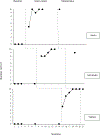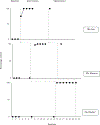Effects of Behavioral Skills Training on Teacher Implementation of a Reading Racetrack Intervention
- PMID: 32606490
- PMCID: PMC7325445
- DOI: 10.1353/etc.2019.0018
Effects of Behavioral Skills Training on Teacher Implementation of a Reading Racetrack Intervention
Abstract
This study examined the effects of behavioral skills training (BST) on teachers' implementation fidelity of a reading racetrack (a board game designed to increase sight word fluency) with elementary students identified as struggling readers. BST, an alternative to traditional professional development, is a performance-based protocol incorporating instruction, modeling, rehearsal, and feedback. A multiple probe design across teacher-student dyads demonstrated that BST was functionally related to the teachers' implementation of a reading racetrack with 100% fidelity on at least three consecutive sessions. Additionally, students met mastery criteria for sight word acquisition and demonstrated maintenance at least one to two weeks post intervention.
Keywords: behavioral skills training; fidelity; intervention; reading.
Figures
References
-
- Archer AL, & Hughes CA (2011). Explicit instruction: Effective and efficient teaching. New York: The Guilford Press.
-
- Archibald S, Coggshall JG, Croft A, & Goe L. (2011). High-quality professional development for all teachers: Effectively allocating resources. Research & Policy Brief National Comprehensive Center for Teacher Quality; Retrieved from http://eric.ed.gov/?id=ED520732
-
- Coggshall JG, & Ott A. (2010). Retaining teacher talent: Convergence and contradictions in teachers’ perceptions of policy reform ideas. Naperville, IL: Learning Point Associates and New York: Public Agenda; Retrieved March 10, 2017, from https://www.publicagenda.org/files/Convergence_Contradiction.pdf
Grants and funding
LinkOut - more resources
Full Text Sources
Miscellaneous



